
A Guide to the Amphibians
and Reptiles of California

Non-Native Species of Amphibians and Reptiles
That Are Established in California
(Also known as introduced species, exotic species, alien species, non-indigenous species, or invasive species (if they have been proven to be harmful.)
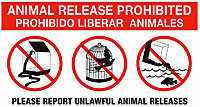 |
| The California Department of Fish & Wildlife has an Invasive Species Program to prevent the spread of invasive species and to reduce their negative effects. You can look through their regulations regarding invasive species here and at Fish and Wildlife Code Section 6400. |
| Report an Invasive Species Sighting to the California Department of Fish and Wildlife |
| Report a Nonindigenous Aquatic Species to the USGS |
| California Department of Fish and Wildlife information about how to prevent introductions of Invasive Species |
| California Department of Fish and Wildlife .pdf About Problem Pets The United States Geological Survey Nonindiginous Aquatic Species website has a database of non-native aquatic species that you can search by state, including California. This excludes non-aquatic species including most lizards and snakes, but you can see several frog and turtle species on the list that have been found in the state that I may not include on my lists. |

| This is a list of non-native species of amphibians and reptiles which have established self-sustaining breeding populations in California. (Some of them may be considered "Invasive Species" which are threatening native wildlife, but I don't show that designation here.) Most of them have arrived recently, spread by humans either intentionally or accidentally. In some cases these established populations may prove to be only temporary and will eventually die out. If that happens they will end up on another page that shows formerly established species. I also have a list of non-native species that have been reported in the state but have not been officially documented and confirmed as established in the state. And I have another list of some of the non-native species commonly kept as pets which are sometimes found in the wild in California. They probably don't represent reproducing populations, but they could become established if enough of them are released into the wild. |
||||||
Whether intentionally or accidentally, humans have always transported non-native species around the world for as long as we have traveled. Since the late 20th century, California, especially Southern California, has also become home to an increasing number of non-native species of lizards along with a few snakes, frogs, turtles, and one salamander. The American Bullfrog, native to eastern North America, was brought to California at the beginning of the 20th century, to be bred for food. Once the bullfrogs escaped into the wild, they quickly populated almost the entire state as well as much of the West. The African Clawed Frog, native to South Africa, was brought to the state in the 1940s for use in laboratories in pregnancy tests and was intentionally and accidentally released into some waters where it found a home. Aquatic Tiger Salamander larvae were used as fish bait. When they escaped the hook, some of them also found a new home in ponds and lakes all over the state. The Red-eared Slider, originally from eastern North America, and a very common pet turtle, has spread throughout California mostly as a result of the release of unwanted pets by negligent owners. The origin of most of the other established non-native herps is more complicated. Many of them originated from the pet trade in non-native herps which began increasing considerably in the 1990s, but others have arrived from outside the state as a result of transportation of goods including as nursery plants and lumber. |
||||||
Released, escaped, or transported herps of almost any species are sometimes found in the wild, especially in heavily-populated areas, but these do not necessarily constitute an established population. See our separate page of Feral Pet Herps found in the state. My intent here is to try to keep track of the established non-native species which are the most common and widespread. There are certainly more species which have become established in small areas in California which are not on this list. More species will probably become established in the state in the future, and some introduced populations will disappear due to competition, climate, disease, intentional eradication, or due to other causes. Please contact me by email if you find any wild non-native amphibians or reptiles in the state. Send a picture if you can. I will try to contact somebody who is working to document them and to keep them from getting established. |
||||||
Non-Native Frogs Established in California |
||||||
| Lithobates (Rana) berlandieri - Rio Grande Leopard Frog | ||||||
| Native to the southeast from the Atlantic to central Texas. Accidentally released near Yuma between 1965 - 1971, quickly spreading along the lower Colorado River area and the Imperial Valley. Range continues to expand. Most likely introduced accidentally with fish plants from Texas or New Mexico. |
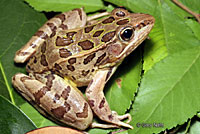 |
|||||
| Lithobates (Rana) catesbeiana - American Bullfrog | ||||||
| Native to the eastern and midwestern United States and southeast Canada. Introduced for food in the 1920's by commercial frog farmers due to its large meaty legs. Now established throughout most of the western United States and southwestern Canada. This frog was included on the 2014 Global Invasive Species Database list of the 100 worst invasive alien species. |
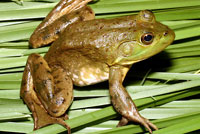 |
|||||
| Lithobates (Rana) sphenocephala - Southern Leopard Frog | ||||||
| Most likely first introduced into the Santa Ana River basin in 1929 or 1930, probably as larvae that arrived with other imported Bullfrogs, fish, and crayfish from Louisiana. Now common in the Prado Flood Control Basin. |
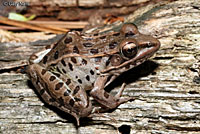 |
|||||
| Xenopus laevis - African Clawed Frog | ||||||
| Originally native to South Africa. Brought to the US in the 1940's and widely used for laboratory study and human pregnancy testing. Also a popular aquarium pet. Escaped and released laboratory animals and released pets were established in California primarily before being banned in the 1960s. |
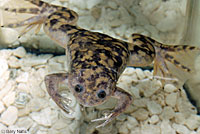 |
|||||
| This frog is listed as established in several locations in Southern California, but there is not much information about where they are. The presence of this non-native frog is more apparent than that of most non-native species because their loud nocturnal calls are annoying and out of place. Most likely, Coqui frogs, or their eggs, arrived in California stowed away in agricultural or other kinds of shipments from Hawaii, Puerto Rico, or other locations where they are established. This frog was included on the 2014 Global Invasive Species Database list of the 100 worst invasive alien species. I first received requests to identify Common Coquis by sound during the summer of 2014 from people in San Diego and Los Angeles who were annoyed with the loud sound they heard all night, (one group of people thought was a bird calling) and wanted to find out what was making the sound and how to get rid of it. (These were just single frogs. Imagine how desperate people would get if there were many frogs calling.) The California Department of Fish and Wildlife includes the Common coqui on their list of invasive species in California: "A single coqui was collected from a private residence in Orange County in 2012 and was determined to have originated by “hitchhiking” on a tropical house plant. Subsequent inspections of the nursery from which the plant was purchased, in San Diego County, detected (heard) multiple calling males and resulted in the collection of one adult, two froglets, and a cluster of coqui eggs. Currently, that population appears to be confined to the single nursery site. However, in 2014, after a month of nightly calling, what homeowners in Ocean Beach (San Diego) thought to be a songbird was determined to be a coqui." The SSAR Official Names List 7th Edition of 2012 also lists this frog as established in California: "The Coqui is native to Puerto Rico, has been reported from four states, and is reported as established in California, Florida and Hawaii. It is widely established on Hawaii Island but is more restricted and the target of eradication efforts on the other Hawaiian Islands. Populations in California and Florida appear to be limited to nurseries (Dalrymple, 1994, Non-indigenous Amphibians and Reptiles in Florida in Schmitz, D. C. and T. C. Brown [eds.] An Assessment of Invasive Non-indigenous Species in Florida's Public Lands, Technical Rpt. TSS-94-100. Florida Department of Env. Protection, Tallahassee, FL., P; 67-78; K. Krysko, pers. comm.; D. Schnabel, pers. comm.) it is uncertain to what extent they are maintained by constant reintroduction, and they perhaps should not truly be considered established." With the Coqui now established throughout the Hawaiian islands, California Department of Food and Agriculture inspectors are carefully inspecting all Hawaiian plant material for the frogs and their eggs, which are laid on leaves. They have already found frogs and their eggs in many shipments of ornamental plants from Hawaii. (James A. Bethke) "Coqui frogs have been reported at Disneyland, Hermosa Beach and at nurseries" is listed as one of the highlights in a meeting of California Department of Food and Agriculture and California Department of Fish and Game [Fish and Wildlife] personnel 12/22/10 in Sacramento. An ABC News report from 3/18/16 mentions a Beverly Hills Coqui whose calling neighbors thought was a broken house alarm prompting them to call the police, and a nursery in Torrance where Coquis appear to be established. They also mention that the tropical frogs are able to survive the semi-arid conditions of Southern California by living in areas that use sprinkler systems, such as nurseries and most homes in the area. You can listen to the sound of a Coqui Frog recorded in Puerto Rico by Karen Cooper Here You can also see and hear a Coqui Frog calling in this YouTube Video The California Department of Fish and Wildlife requests you take this action if you find a Common coqui: "If this species is found (or heard) in California, do not release it. Immediately contact the CDFW Invasive Species Program to report your sighting at www.wildlife.ca.gov/Conservation/Invasives/report, by email to Invasives@wildlife.ca.gov, or by calling (866) 440-9530." |
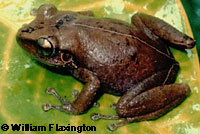 © William Flaxington © William Flaxington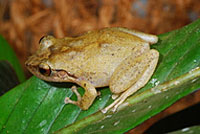 © 2008 Dr. Peter Janzen |
|||||
Non-Native Salamanders Established in California |
||||||
| Ambystoma mavortium (tigrinum) - Western Tiger Salamander |
||||||
| Introduced into isolated locations in California, most likely through the introduction of larvae used as fishing bait that were accidentally released. Expanding irrigation in arid areas can help to encourage their spread. |
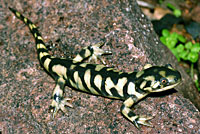 |
|||||
Non-Native Lizards Established in California |
||||||
| (Also known as Bosc's Fringe-fingered Lizard) Lizards in the genus Acanthodactylus (Fringe-fingered Lizards, Spiny-toed Lizards, Fringe-toed Lizards) not native to California have been established in a small agricultural--industrial area in coastal Ventura County. (Other non-native lizards have also been found in the area, which appears to be a place where people dump unwanted pets.) Acanthodactylus are similar in appearance to native whiptails but the pattern is different and they have small fringes on the hind toes that whiptails lack. The lizards that became established were probably escapees or releases from a reptile importer that is now defunct. The lizards were introduced approximately in 2021 or 2022, and first observed in 2023. As of April, 2024, biologists with the U.S. Geological Survey and the U.S. Fish and Wildlife Service are continuing to work on removing them. Since they are limited to a small area there is a good chance they will succeed. The lizards introduced into Ventura County have been identified on iNaturalist as Acanthodactylus boskianus - Bosc's Fringe-toed Lizard (Daudin, 1802) (endemic to North Africa and Western Asia).There are approximately 40 species of Acanthodatylus and it is not clear if the Ventura County lizards were identified as that species based on physical characteristics and DNA or because it is a species known to be sold in the pet trade. "The approximately 40 species in the genus Acanthodactylus are native to a wide area in North Africa, southern Europe and Western Asia; across the Sahara Desert, to the Iberian Peninsula, and east through the Arabian Peninsula, to Afghanistan and western India." They prefer dry, sparsely-vegetated areas, but they are not uncommon in other environments. (Wikipedia 4/4/24) |
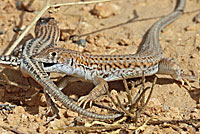 Bosc's fringe-toed lizards (Acanthodactylus boskianus asper) love bite as part of courtship, Dana Biosphere Reserve, Jordan © Charles J. Sharp Bosc's fringe-toed lizards (Acanthodactylus boskianus asper) love bite as part of courtship, Dana Biosphere Reserve, Jordan © Charles J. Sharp(This is a smaller version of the original with a copyright added to it. Click on the image to see the original.) |
|||||
| Anolis carolinensis - Green Anole | ||||||
| This species is native to the south and southeastern United States and is present and probably established at a number of locations in coastal Southern California. They probably originated as released pets, as they have been widely available in the pet trade, but it's also possible that anoles and their eggs have been transported in shipments from the Southeast. |
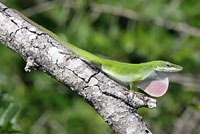 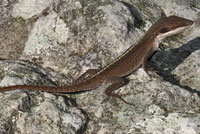 |
|||||
| Anolis sagrei sagrei - Cuban Brown Anole |
||||||
| I received reports with pictures of established populations of Brown Anoles on a one acre palm garden in Vista and at another location in Santa Ana. I contacted some Southern California herpetologists who went to the site and published a report, documenting the first state record of this species established in California in Herpetological Review 45(4), 2014, which you can see on the A. sagrei page. I have received reports that a population of this lizard exists at a private residence and its surroundings in Palm Desert and another in Rancho Mirage. I have not been able to confirm these yet, but photographs show the species and the presence of several lizards indicates an established population. I have received another report showing a neonate lizard found at a residence in Orange County. The origin of these lizards is not clear - they might have been transported in agricultural shipments from Florida or Hawaii, or they might have originated from released pets. |
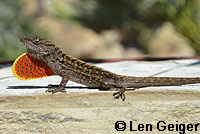 © Len Geiger |
|||||
| Aspidoscelis sonorae - Sonoran Spotted Whiptail | ||||||
| First reported seen in Irvine, Orange County, in 2014. They were first identified as a hybrid of two whiptail species native to Arizona, New Mexico, and Mexico, but study in 2018 concluded that the two species are actually only one species, A. sonoarae. As of 2/21 these whiptails have been found only in Orange County and in northern San Diego County, but they appear to be spreading. Found in landscaping and on parking lot asphalt. Described by Winkleman and Backlin as "...strongly acclimated to the urbanized environment and readily using spaces underneath concrete slabs for shelter." "Presumably introduced as a single released/escaped pet that subsequently underwent asexual reproduction and established a small, localized population." Striped non-native whiptails have also been found in Sacramento and in a few locations northeast of Sacramento, but it has not yet been determined if they are established or if they are the same mixed species as these. |
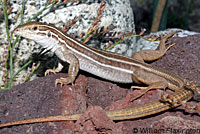 © William Flaxington © William Flaxington |
|||||
| Aspidoscelis tesselatus - Common Checkered Whiptail | ||||||
| Introduced at Long Beach, Los Angeles County. (Hansen and Shedd, 2025) Native range is parts of Texas, New Mexico, Colorado, Oklahoma, and Chihuahua and Coahuila, Mexico. |
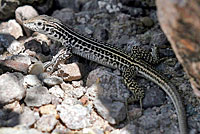 |
|||||
| Chalides ocellatus - Ocellated Skink | ||||||
| (Also known as Ocellated Bronze Skink, Eyed Skink, Gongilo) In September 2021 I received a report of a population of Ocellated Skinks near Ontario, San Bernardino County. More than one was seen at the location. You can see a picture of one of these skinks on iNaturalist. This population and another in Hesperia were documented in 2023. (Pauly, Kennedy, Spurlock, and Clarkson. Herpetological Review 54(3), 2023) Native to southern Europe, North Africa, and the Middle East, the species has also been established in the Phoenix, Arizona metropolitan area and in multiple locations in Florida. Because the Ocellated Skink can tolerate desert and Mediterranean climates, there is a lot of opportunity for them to spread throughout developed areas of Southern California. In October 2022 another possible population of Chalcides was observed in La Mesa, San Diego County. The population was confirmed in May 2023 when two skinks were captured and filmed. More pictures and information: iNatualist Wikipedia The Reptile Database Natural History Museum of Los Angeles County article 4/23 |
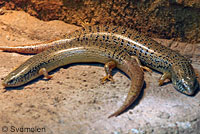 © Svdmolen - Wikipedia |
|||||
| (Known by several other names: Keeled Rock Gecko, Bow-footed Gecko, Rough-tailed Bowfoot Gecko, Rough Bent-toed Gecko, Common Tuberculate Ground Gecko, and Keeled Gecko) This species was first reported in California in 2019 at Fort Irwin in San Bernardino County, where it was probably a stowaway on a military airplane returning from the Middle East. It is not yet known if there is an established population there. In January 2021 it was also found near Death Valley in Inyo County, California, by Elliot Jaramillo. The species is thought to have been established there through shipments transported from Las Vegas, where it has been introduced. A vouchered record of the species in California was first documented in December 2021. (Hansen & Nafis, Herpetological Review 52(4), 2021). Native to eastern Africa on the shore of the Red Sea, the Middle East, Western Asia, from Egypt east to Pakistan and northwest India and north to southern Turkey. Also introduced into Galveston, Texas, and Arizona, mostly in the greater Phoenix area. |
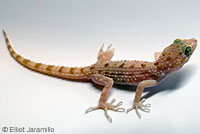 © 2021 Elliot Jaramillo © 2021 Elliot Jaramillo |
|||||
| Hemidactylus garnotii - Indo-Pacific Gecko | ||||||
| (Also known as Fox Gecko; Garnot's House Gecko) This gecko is native to South and Southeast Asia, the East Indies, and many South Sea islands, including Northeast India, Bangladesh, Nepal, Myanmar, Thailand, the Malaysian Peninsula, Southern China, Taiwan, the Philippine Islands, Indonesia, New Guinea, new Caledonia, Polynesia, Fiji, Western Samoa, Vanuatu, the Cook Islands, and Tonga. It has been established in Florida, Georgia, Hawaii, Texas and California, and in the Bahamas and Costa Rica. Range in California Documentation of this species in California was first published in December 2015. (Gregory B. Pauly and Glen S. Yoshida. Herpetological Review 46(4), 2015.) A population was found in Torrance, Los Angeles County, where it has been observed active during every month of the year since 2011. This population is apparently confined to one house lot. It has spread to a few locations only so far (4/20) mostly in Orange County, with a few others in Los Angeles and San Diego counties. |
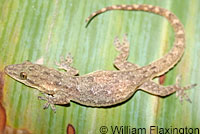 © William Flaxington 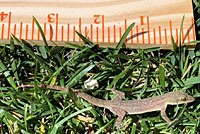 |
|||||
| Hemidactylus mabouia - Tropical House Gecko | ||||||
| (Also known as African House Gecko; Wood Slave) This species, originally from sub-Saharan Africa, was introduced to the Americas transported on ships involved with the slave trade. It has become well-established in much of Florida, the Caribbean, Central America, and South America. In Florida, it has replaced the once-common Mediterranean Gecko, Hemidactylus turcicus. It has also been found at several locations in Orange County and San Diego County. I am not yet aware of any published information reporting that they are established anywhere in California, but they certainly are. When last checked ( March, 2021) there are iNaturalist observations for H. mabouia from several locations in Orange County - Newport Beach, Santa Ana, Costa Mesa, and Tustin, and from locations in San Diego County at Chula Vista and San Diego, and another observation in Santa Cruz, with the earliest in San Diego in 2014. On the H.E.R.P. database, there are also several records from Orange County and one from San Diego County, with the earliest being from San Diego in 2013. |
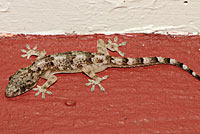 |
|||||
(Also known as Asian Flat-tailed House Gecko; Flat-tailed Gecko; Asian House Gecko; Frilled House Gecko. Also known as Cosymbotus platyurus.) |
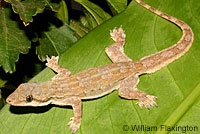 Adult, Orange County Adult, Orange County © William Flaxington |
|||||
| Hemidactylus turcicus - Mediterranean Gecko | ||||||
| Native to the Mediterranean region. This gecko has spread rapidly throughout world, probably through human transportation of lizards and their eggs in shipments of nursery plants, lumber, and other goods. A fairly recent arrival in California, continuing to expand its range. Now widespread in the southern part of the state and southern San Joaquin Valley. Most likely this species originated from stow-aways transported into the state from Florida or Texas or other areas where they became established. |
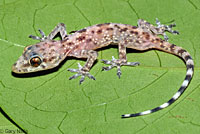 |
|||||
| Podarcis siculus - Italian Wall Lizard | ||||||
| A population of this Mediterranean lizard occurs in a suburban neighborhood in San Pedro, Los Angeles County. The lizards were intentionally introduced in 1994 by someone who brought them from Italy. They have been identified as Podarcis siculus siculus - Southern Italian Wall Lizard. Details are given in: Deichsel, Guntram, Gary Nafis, and Jonathan Hakim. Herpetological Review Volume 41, Number 4 - December 2010 P. 513-14 They have also been found in Torrance and Whittier. Another population of Podarcis was documented in San Marcos, San Diego County, in September 2016. (Herpetological Review 47(3), 2016.) These have been identified as the subspecies Podarcis siculus campestris - Northern Italian Wall Lizard. |
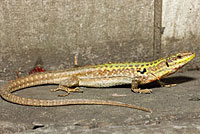 |
|||||
| Ptyodactylus hasselquistii - Yellow Fan-fingered Gecko | ||||||
| In their 2025 California field guide, p.167, Hansen and Shedd report that this species has been established in Orange County, California: "First observed in California in 2015 near a reptile-breeding facility." ... "A small but reproductively active population is restricted to an urban site in Santa Ana (Orange Co.; elev. less than 70 ft./21m)." The 2025 SSAR scientific and common names list also lists the species as present in California based on the Hansen and Shedd book, but I have not yet been able to find any other reports of the species in the state. iNaturalist does not show them in Orange County nor does the H.E.R.P. database and I have not been able to find any museum records for the species from California. The Center for North American Herpetology has a California page for the species which is also based solely on Hansen and Shedd. Native Range Wickipedia reports the native range as northern Africa and western Asia, including "Algeria, Cameroon, Egypt, Eritrea, eastern Ethiopia, Iraq, Israel, Jordan, Lebanon, Saudi Arabia (including the Farasan Islands), northern Somalia, Sudan, and Syria." |
 © 2009 Frank Teigler - CalPhotos More pictures of this species can be viewed at GeckoWeb Wickipedia The Reptile Database iNaturalist |
|||||
| Tarentola annularis - Ringed Wall Gecko (White-spotted Wall Gecko) | ||||||
| In 2006 it was reported on the internet that there was a population of these geckos in Redlands, San Bernardino County. "...there is a thriving population of Tarentola annularis in the downtown Redlands area. I've had reports of neonates from as much as 3 miles from the possible spot of the original introduction." William Flaxington confirmed that they were there in 2007. Jonathan Hakkim confirmed that they are still present in 2012. In 2013 I gave William Flaxington's locality information to a Natural History Museum of L.A. County herpetologist who published the first documentation of the species in California in September, 2014. (Herpetological Review 45(3), 2014) The species Tarentola annularis - Ringed Wall Gecko, is listed on the 2008 SSAR Alien Species list as native to northern Africa and established in Florida. The most likely origin of these geckos is from escapees at a pet store. |
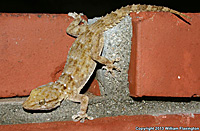 Adult, Riverside County Adult, Riverside County© William Flaxington |
|||||
| Tarentola mauritanica - Moorish Gecko |
||||||
| Native to Mediterranean countries, found in isolated localities in California. Released or escaped pets are most likely the origin. The extent of the establishment of this species is not well known. Reported as introduced and established in San Diego County, California. (Mahrdt, 1998, Herpetol. Rev. 29: 52) I have also received a report that a population of these geckos inhabited a building in Hanford years ago, and might still be there. These geckos probably orinated in the state from intentional or accidental releases of pets. |
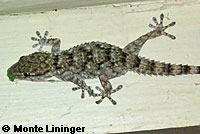 © Monte Lininger © Monte Lininger |
|||||
| Trachylepis Quinquetaeniata - African Five-lined Skink | ||||||
| An established population of this species was first recorded in Glendora in eastern Los Angeles County in 2018 after being reported on iNatualist. The species is found in the reptile trade. The skinks in the original population in Glendora are thought to be derived from skinks kept by a reptile dealer living in the neighborhood, who imported some of them from Egypt in September 2014. Other exotic reptiles have been observed roaming free in the neighborhood, too. Residents report that there was a rapid population increase of African Five-lined Skinks in the summer and fall of 2018. (Gregory B. Pauly and Patrick D. Gavid. Geographical Distribution Note. Herpetological Review 50(1), 2019) Efforts to eradicate the skinks appear to have been successful as there have been no new observations since 2020, so I may be taking this species off this list. |
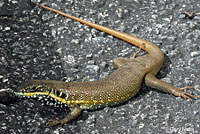 Adult male, St. Lucie County, Florida |
|||||
| Trioceros jacksonii - Jackson's Chameleon | ||||||
Native to East Africa. In California, Jackson's Chameleons have been introduced into San Luis Obispo, Los Angeles, and San Diego Counties. (McKeown, 1997 Bull. Chicago Herpetol. Soc. 32:101.) Locations include Morro Bay, Laguna Beach, and possibly the Palos Verde Peninsula. |
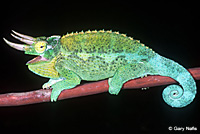 |
|||||
Non-Native Snakes Established in California |
||||||
|
It is unlawful to import, transport, or possess any Watersnakes of the genus Nerodia in California except under permit issued by the California Department of Fish and Wildlife. (California Code of Regulations, Title 14, Excerpts, Section 671) The California Watersnakes Site reports on news, publications, and sightings related to non-native watersnake species (Nerodia) in California. If you see a watersnake in the wild in California at a location not mentioned on the California Watersnakes Site, please report it to California Nerodia Watch at iNaturalist. (Don't confuse Watersnakes (Nerodia) with native California gartersnakes. Most gartersnakes have stripes on the sides and sometimes on the back. Watersnakes have no stripes.) |
||||||
| Nerodia fasciata - Southern Watersnake | ||||||
| Native from the southeast into central Texas. Established in at least three locations in California, most likely originating from intentionally or accidentally released pets. 1 - Established in and around Lake Natoma in the city of Folsom, Sacramento County, most likely from escaped or released pets. First documented in 1992 in Folsom. See: Stitt, Balfour, Luckau, Edwards - U.S.Fish and Wildlife Service Report, April 2005. 2 - Established at Lake Machado in Harbor City, Los Angeles County. Watersnakes in Harbor City have been identified as Nerodia fasciata pictiventris - Florida Watersnake. (2006. Herpetol. Rev. 37:363). According to Michael Fuller of the Nerodia Working Group, a reproducing population of N. fasciata has existed in Harbor City in Los Anageles for several years. While the snakes key out to N. f. pictiventris morphologically, preliminary mDNA results (as of 9/08) suggest that they are Nerodia clarkii, or possibly hybrids of N. clarkii and N. f. pictiventris. The habitat is a freshwater lake, typical of that used by N. fasciata, while N. clarkii typically inhabit brackish waters. Biologists from the USGS and CDFW with authorization from the LA Dept. of Parks and Recreation have made efforts to eradicate Nerodia from the lake. In 2010 approximately 300 Florida watersnakes were trapped and removed. Necropsies on the snakes performed by biologists with the USGS, the US Fish and Wildlife Service, and UC Davis, found no remains of native species in their digestive tracts. Instead, the watersnakes were found to prey mostly on other invasive species found in the lake. According to USGS snake ecologist Robert Reed, young snakes prey mostly on nonnative mosquito fish, while older snakes prey on bullfrogs, and bullfrog tadpoles. The ongoing effort to clean up the lake and improve the water quality will increase the food source for the snakes and won't reduce their number. Reed says that the lake would have to be drained for at least a year in order to get rid of the source of food for the watersnakes, which would be the only sure way to get rid of the snakes. LA Times 6/11/16 3 - In October 2015 state biologists confirmed the presence of southern water snake (Nerodia fasciata) at the Laguna Dam, Senator's Wash, and potentially nearby Mittry Lake, northeast of Yuma Arizona along the Colorado River at the border of California and Arizona. These snakes may have been introduced as released pets, but there is also a chance that they were brought to the area concealed in equipment that was brought in from the southeastern U.S. to a nearby U.S. Army base in Arizona. |
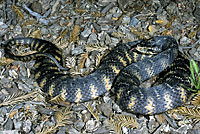 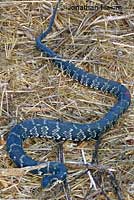 |
|||||
| Nerodia sipedon - Northern Watersnake | ||||||
| According to Michael Fuller of the Nerodia Working Group, and my own observations, a population exists in the vicinity of Roseville, Placer County, which is fairly close to the Folsom population of N. fasciata. These snakes most likely originated from intentionally or accidentally released pets. |
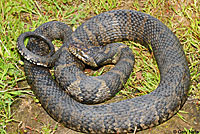 |
|||||
| Indotyphlops braminus - Brahminy Blind Snake | ||||||
| (Also known as Flowerpot Snake; Common Blind Snake; Island Blind Snake; Hawaiian Blind Snake)) Native to South Asia and introduced around the world. First reported from Chula Vista in Herp Review, December 2010. Apparently spreading around Southern California. These snakes most likely originated as stow-aways in the soil of nursery plants from areas where they are established, such as Florida and Hawaii. |
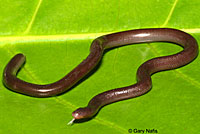 |
|||||
Non-Native Turtles Established in California |
||||||
| Apalone spinifera emoryi - Texas Spiny Softshell | ||||||
| Native to Texas and New Mexico. Probably first introduced into the Colorado River system, but I have not found out how or why. Now ranges throughout the Colorado River and the Imperial Valley and in other Isolated populations, including several locations in San Diego County. |
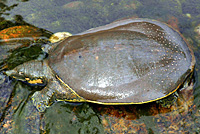 |
|||||
| Apalone ferox - Florida Softshell | ||||||
| Native Range is most of Florida, including Big Pine Key where it is possibly introduced, north to South Carolina, southern Georgia, and Mobile Bay in Alabama. In California, found mostly in the San Francisco Bay Area and the Los Angeles Basin in areas with large populations. Apparently established in some locations where multiple turtles have been observed. All specimens found appear to be the result of the illegal release of unwanted pet turtles with no evidence to indicate that Florida Softshells are moving from their sites of introduction and colonizing new areas. |
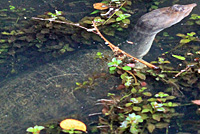 |
|||||
| Chelydra serpentina - Snapping Turtle | ||||||
| Introduced into a number of isolated localities in the state, probably as a result of the release of unwanted pets. May not be breeding in all locations. |
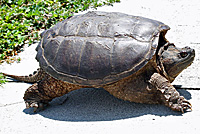 |
|||||
| Chrysemys picta bellii - Western Painted Turtle | ||||||
| Established in many locations in ponds throughout the state, especially in the coastal south, probably as a result of the release of unwanted pets. Once thought to be native to extreme northern California. |
 |
|||||
| Pseudemys concinna - River Cooter | ||||||
A large mostly-aquatic freshwater diurnal turtle found in rivers, lakes, and ponds. Typically observed when basking on rocks, logs, or shores. In California, observed mainly in densely-populated areas in the S.F. Bay Area, the Los Angeles Basin, the Sacramento area, and in San Diego County. It is not known yet if it has been established and breeding in any location other than at Otay Lake in San Diego County. |
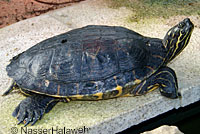 |
|||||
| © NasserHalaweh 2010 CC BY-SA 4.0 | ||||||
| Sternotherus odoratus - Eastern Musk Turtle | ||||||
| Native to most of eastern North American, known to be established in Davis, Yolo County, but individuals have been found in the Sacramento area, San Francisco, Los Gatos, Los Angeles, Fountain Valley, and coastal San Diego County. They don't appear to represent breeding populations, only lone pet turtles that were released into the wild, but it's possible they have also been established at one or more of those locations. | 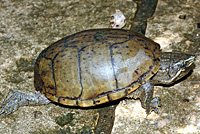 |
|||||
| Trachemys scripta elegans - Red-eared Slider | ||||||
| Native to the south and midwest, from eastern New Mexico north into Chicago and south to the Gulf Coast of Alabama and Georgia. Found throughout California. A common pet turtle. The release of unwanted pets is largely responsible for the wide introduction of this species in California. Interbreeds with the Yellow-bellied Slider. This turtle was included on the 2014 Global Invasive Species Database list of the 100 worst invasive alien species. |
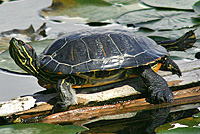 |
|||||
| Trachemys scripta scripta - Yellow-bellied Slider | ||||||
| Occurs naturally along the southeast coast of the U.S. in Virginia, the Carolinas, Georgia, the Florida Panhandle and extreme southern Alabama. Found throughout California, so far mostly in well-populated areas along the coast. A common pet turtle. The release of unwanted pets is largely responsible for the introduction of this species in California. Interbreeds with the Red-eared Slider. |
 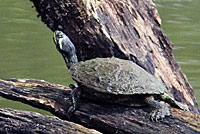 |
|||||
Return to the Top
© 2000 -